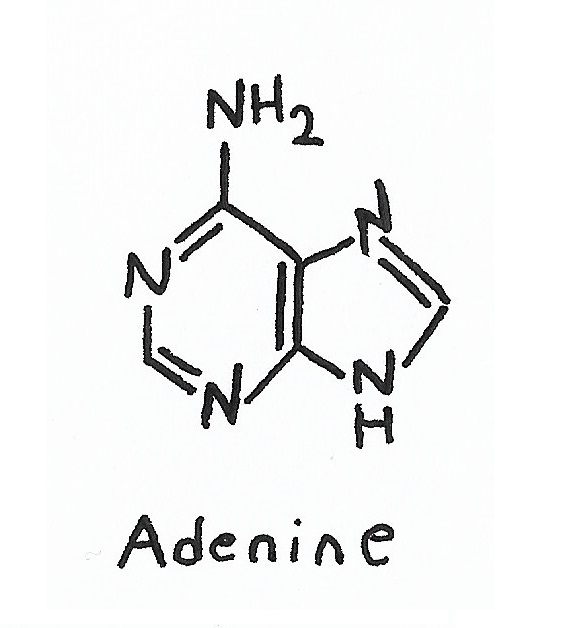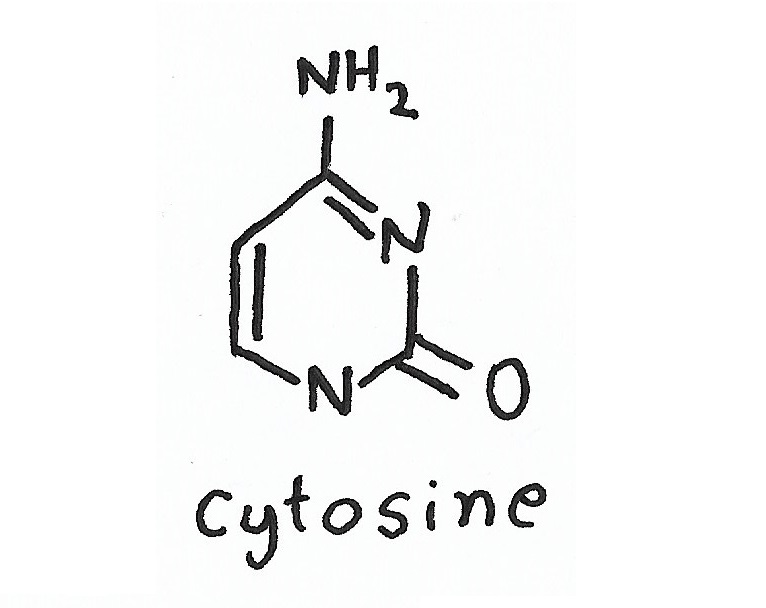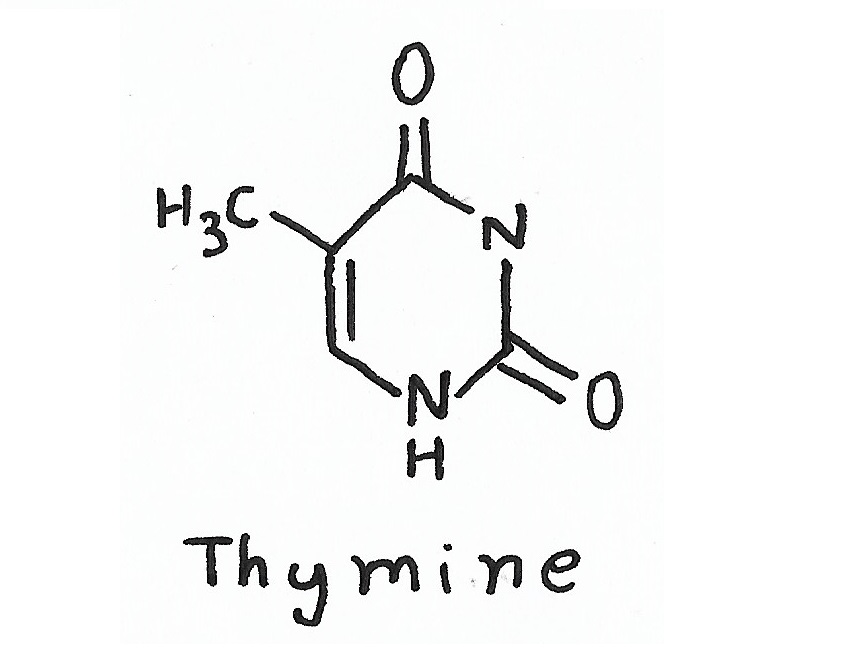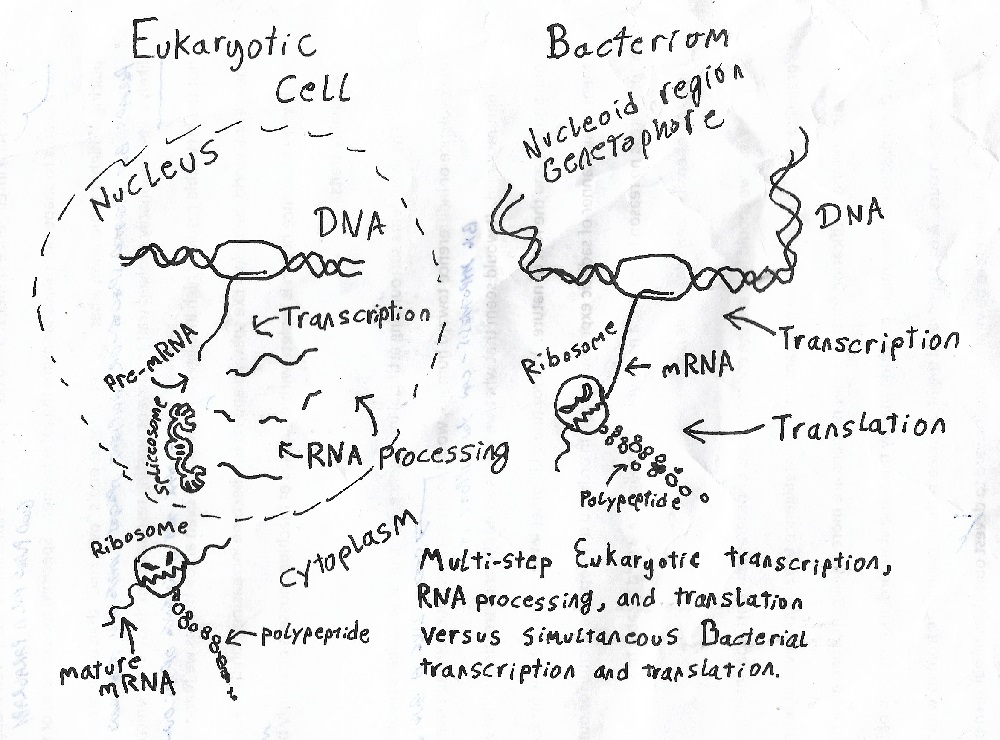Nucleic Acid
Introduction
Nucleic acids form the informational basis of all cellular lifeforms, from bacteria to vertebrates. Strands of nucleic acids are made up of codons, each codon a sequence of three nucleotides coding for a particular amino acid. A sequence of codons that results in a peptide (which can in-turn fold to become a protein) is known as a gene. A closed circle made up of all of an organisms’s genes is known as a genophore; although some organisms, called “eukaryotes” (basically large, complicated archaea) have a linear genome broken up into segments called chromosomes.
Roles of Nucleic Acids
The following categorization scheme for the roles of nucleic acids and nucleotides was endorsed by Dr. Andrew Brabban Ph.D in the class Chemistry of Living Systems at The Evergreen State College.
|
Information Storage — DNA, dRNA, RNA |
|
|
Information Conveyance — mRNA/tRNA, cAMP, cGMP, ppGpp |
|
|
Energy — ATP, ADP, AMP, NAD+, FAD, |
|
|
Catalysis — rRNA |
The Nitrogenous Bases (Nucleobases)
These make up the basis of the oft-cited “four-letter code” used by RNA and DNA.
 |
Adenine — a purine-based nucleobase that is both synthesized within the body and found in abiotic environments. Abiotic environments include meteorites such as carbonaceous chondrites (Stoks & Schwartz, 1979; Shapiro, 1998; Peeters et al., 2003; Martins et al., 2006). |
 |
Guanine — a purine-based nucleobase that is both synthesized within the body and found in abiotic environments. Abiotic environments include meteorites such as carbonaceous chondrites (Stoks & Schwartz, 1979; Shapiro, 1998; Peeters et al., 2003; Martins et al., 2006). |
 |
Uracil — a pyrimidine-based nucleobase that is both synthesized within the body and found in abiotic environments. Abiotic environments include meteorites such as carbonaceous chondrites (Stoks & Schwartz, 1979; Shapiro, 1998; Peeters et al., 2003; Martins et al., 2006). |
 |
Cytosine — |
 |
Thymine — |
Transcription & Translation
DNA doesn’t directly turn into amino acids, however. First it basepairs with other nucleotides to generate a tRNA molecule in a process known as transcription. This is then translated into messenger RNA or mRNA (eukaryotic cells add an extra step to this by having a preliminary RNA strand coded with fidelity to the original DNA code, which then has introns snipped from it to produce a streamlined “mature” RNA strand). The mRNA is then read by the ribosome, which releases amino acids in a sequence prescribed by the mRNA, and ultimately, the DNA.

Figure 1 — Complex eukaryotic transcription & translation (left) versus streamlined bacterial transcription & translation (right). While bacterial transcription & translation can’t be truly described as simpler in any absolute sense (for they have more functions going on simultaneously at any given time and are in that way doubly complex as compared to eukaryotes), the process is definitely much-streamlined and has completely done away with complex steps.
Abiotic Origins of Nucleobases
The purine bases adenine and guanine have been detected in meteorites, although the only pyrimidine-base compound formally reported in meteorites is uracil (Stoks & Schwartz, 1979), however cytosine cannot be ruled out (Shapiro, 1998; Peeters et al., 2003; Martins et al., 2006) and ultraviolet irradiation of low-temperature ices (the dominant phase of H2O in cold astrophysical environments is ice, and most ices in such environments are H2O-rich) has been shown to produce not only amino acids, quinones, and amphiphiles, but have also, with the introduction of pyrimidine, been shown to produce uracil (Nuevo et al., 2009), cytosine, and even thymine, though the abiotic synthesis of thymine is less straightforward compared to other pyrimidine-base compounds (Sandford et al., 2014). (That this would logically make the prebiotic synthesis of RNA easier than that of DNA could explain why RNA has a larger repertoire of functions than does DNA in modern cells.) Additionally, ribose and related sugars have been produced experimentally in astrophysical ice analogues (Meinert et al., 2016).
Cytosine can be synthesized from cyano-acetylene and cayanate, this is unlikely to have occured in acqueous media as cayanate is rapidly hydrolized into CO2 and NH3.
Cyano-acetylene is an abundant interstellar molecule and can by produced by a spark discharge in a CH4/N2 environment.
hydrolysis of cyanoacetylene leads to cyanoacetaldehyde
reaction of cyanoacetaldehyde with urea produces cytosine in 30-50% yields
Hydrolysis of cytosine leads to uracil
References
Z. Martins (1), O. Botta (2), M. L. Fogel (3), M. A. Sephton (4), D. P. Glavin (2), J. S. Watson (5), J. P. Dworkin (2), A. W. Schwartz (6) and P. Ehrenfreund.
Cornelia Meinert1,*, Iuliia Myrgorodska1,2, Pierre de Marcellus3, Thomas Buhse4, Laurent Nahon2, Søren V. Hoffmann5, Louis Le Sergeant d’Hendecourt3, Uwe J. Meierhenrich1,* Ribose and related sugars from ultraviolet irradiation of interstellar ice analogs. Science 08 Apr 2016: Vol. 352, Issue 6282, pp. 208-212 DOI: 10.1126/science.aad8137
<http://science.sciencemag.org/content/352/6282/208>
Michel Nuevo, Stefanie N. Milam, Scott A. Sandford, Jamie E. Elsila, and Jason P. Dworkin. “Formation of Uracil from the Ultraviolet Photo-Irradiation of Pyrimidine in Pure H2O Ices". ASTROBIOLOGY. Volume 9, Number 7, 2009 Mary Ann Liebert, Inc. DOI: 10.1089 ast.2008.0324
https://science.gsfc.nasa.gov/691/analytical/PDF/Nuevo2009.pdf
-- Z. Peeters and O. Botta, S. B. Charnley, R. Ruiterkamp and P. Ehrenfreund, The Astrobiology of Nucleobases. The Astrophysical Journal, 593:L129-L132, 2003 August 20 Received 2003 May 9; accepted 2003 July 11; published 2003 July 29
http://iopscience.iop.org/article/10.1086/378346/fulltext/17377.text.html
Michael P. Robertson & Stanley L. Miller. An efficient prebiotic synthesis of cytosine and uracil. Nature 375, 772–774 (29 June 1995). doi:10.1038/375772a0 Received: 25 January 1995 Accepted: 01 May 1995 Published online: 29 June 1995
https://www.nature.com/articles/375772a0
Scott A. Sandford, Partha P. Bera, Timothy J. Lee, Christopher K. Materese, and Michel Nuevo. Photosynthesis and Photo-Stability of Nucleic Acids in Prebiotic Extraterrestrial Environments. Top Curr Chem (2014) DOI: 10.1007/128_2013_499
http://www.astrochemistry.org/docs/2014%20Sandford%20et%20al.-ToCC%20Chapter%20on%20Nucleobases-Ch.14.pdf
S. A. Sandford, M. Nuevo, and C. K. Materese. Formation of Nucleobases from the UV Irradiation of Pyrimidine in Astrophysical Ice Analogs. NASA. Astrophysics. ARC-E-DAA-TN12718. Conference paper. Mar 17, 2014. 20140006936 (Acquired Jun 28, 2014)
https://ntrs.nasa.gov/archive/nasa/casi.ntrs.nasa.gov/20140006936.pdf
Shapiro, R. Prebiotic cytosine synthesis: A critical analysis and implications for the origin of life. (1999) PNAS, vol. 96 no. 8, 4396-4401. (received for review November 19, 1998)
<http://www.pnas.org/content/96/8/4396.full
Stoks P. and Schwartz A. Uracil in carbonaceous meteorites. Nature, 282, 709 (1979)
https://www.nature.com/articles/282709a0

